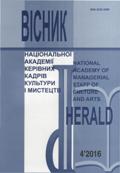ОСОБЛИВОСТІ СТАНОВЛЕННЯ СПІВРОБІТНИЦТВА УДОЖНИКА З ГАЛЕРИСТОМ В УМОВАХ ФОРМУВАННЯ ВІТЧИЗНЯНОГО АРТ-РИНКУ
The Process of Collaboration between the artist and the gallery owner in the conditions of domestic art-market development
Author(s): Olena ZaichenkoSubject(s): Visual Arts, Cultural Anthropology / Ethnology, Management and complex organizations
Published by: Національна академія керівних кадрів культури і мистецтв
Keywords: art gallery; art market; gallery space; collector; gallery owner; creative personality
Summary/Abstract: The goal of the paper. The development and up-to-date state of Ukrainian art market is analyzed. Due to the historical, cultural and economical circumstances of the country the art market here is based on a variant of the western European market model without taking into account local peculiarities and the absence of adequate law system in the field of art. The author investigates the causes and effects of the internal segregation of the art milieu in Ukraine. From this point of view the author discusses problems concerning the adapting of the optimal model of the development of western European art gallery environment to the specific art environment of Ukraine. Ethical questions related to the cooperation between gallery managers and artists are discussed. The necessity of creating an ethical code for gallery managers and artists is underlined; at present this subject has been dealt with only in several published papers. The methods of investigation include historical and cultural aspects, art management and the cooperation between gallery managers and artists viewed from inside, taking into account the world view of both sides. Such complex methodological approach allows to determine and to analyze different kinds of behavior of art market participants in the process of creating the market, developing it and transforming in order to find such model of cooperation that would be based on the thorough knowledge of artists' psychology and the mechanisms of artists' popularity. The scientific novelty of the paper consists in the widening of the conceptions related to the creative activities and the economical survival of the artists in the existing conditions of the market of cultural wealth. Peculiar aspects of the development of art galleries during the post-Soviet period have been investigated in a number of papers, but the specific features of the cooperation between gallery managers and artists viewed from inside were not discussed until now. The comparison of western European and Ukrainian art market models in their historical and cultural contexts allows both to get deeper insight into the problem of transforming the existing situation at the market of cultural wealth and to implement the corresponding projects in practice. Conclusions. In spite of all difficulties, Ukrainian art market is developing quite actively. The number of directions, styles and forms of creative work becomes rather wider than narrower, art events become more frequent, the structure of the domestic art market becomes more diversified and perfect step by step. This process, in turn, favours the constructive development of the interaction between artists, curators and gallery managers as well as their integration to the European art milieu.
Journal: Вісник Національної академії керівних кадрів культури і мистецтв
- Issue Year: 2016
- Issue No: 4
- Page Range: 79-85
- Page Count: 7
- Language: Ukrainian

